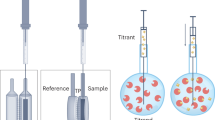Abstract
In this work we rigorously demonstrate that, in dilute solutions, the partial enthalpy of interaction of the ligand can be measured by a forward titration and that the partial enthalpy of interaction of the macromolecule with the ligand can be calculated from the Gibbs–Duhem equation. Using a reverse titration, it is possible to experimentally obtain the partial enthalpy of interaction of the macromolecule and to calculate that of the ligand. Based on this fact, we propose a thermodynamic criterion to experimentally discern when the forward process is equal to or different from the reverse process: they are equal (or different) if the interaction partial enthalpies obtained experimentally are equal to (or different from) those calculated from the Gibbs–Duhem equation. The above criterion is applied to four systems taken from the literature. The first system features the interaction between a bilayer and a surfactant. The second system features a binding interaction with two binding sites that are equivalent and independent. The final two systems feature binding interactions with two non-equivalent binding sites.










Similar content being viewed by others
References
Grolier, J.-P.E., del Rio, J.M.: Isothermal titration calorimetry: a thermodynamic interpretation of measurements. J. Chem. Thermodyn. 55, 193–202 (2012)
Herrera, I., Winnik, M.: Differential binding models for isothermal tritration calorimetry: moving beyond the Wiseman isotherm. J. Phys. Chem. 117, 8659–8672 (2013)
Grolier, J.-P.E., del Rio, J.M.: On the physical meaning of the isothermal titration calorimetry measurements in calorimeters with full cells. Int. J. Mol. Sci. 10, 5296–5325 (2009)
Blandamer, M.J., Cullis, P.M., Engberts, J.B.F.N.: Titration calorimetry. J. Chem. Soc. Faraday Trans. 94, 2261–2267 (1998)
Blandamer, M.J.: Thermodynamic background to isothermal titration calorimetry. In: Ladbury, J.E., Chowdhry, B.Z. (eds.) Biocalorimerty. Applications of Calorimetry in Biological Scienes, pp. 6–25. John Willey and Sons, Chichester (1998)
Kresheck, G.C.: Determination of the relative partial molar enthalpy of decyldimethylphosphine oxide in H2O and D2O. J. Colloid Interface Sci. 187, 542–543 (1997)
Kresheck, G.C.: Erratum in Article No. CS964685, ‘‘Determination of the relative partial molar enthalpy of decyldimethylphosphine oxide in H2O and D2O at 25 °C’’. J. Colloid Interface Sci. 203, 231 (1998)
Heerklotz, H., Binder, H., Schmiedel, H.: Excess enthalpies of mixing in phospholipid–additive membranes. J. Phys. Chem. B 102, 5363–5368 (1998)
Velázquez-Campoy, A.: Ligand binding to one-dimensional lattice-like macromolecules: analisis of the McGhee–von Hippel theory implemented in isothermal titration calorimetry. Anal. Biochem. 348, 94–104 (2006)
Houtman, J.C.D., Brown, P.H., Bowden, B., Yamaguchi, H., Appella, E., Samelson, L., Schuck, P.: Studying multisite binary and ternary protein interactions by global analysis of isothermal titration calorimetry data in SEDPHAT: application to adaptor protein complexes in cell signaling. Protein Sci. 16, 30–42 (2007)
Martinez, J.C., Murciano-Calles, J., Cobos, E.S., Iglesias-Bexiga, M., Luque I., Ruiz-Sanz, J.: Isothermal Titration Calorimetry: Thermodynamic analysis of the binding thermograms of molecular recognition events by using equilibrium models. In: Elkordy, A.A. (ed.) Applications of calorimetry in a wide context—differential scanning calorimetry, isothermal titration calorimetry and microcalorimetry, pp. 73–104. InTech (2013)
Pantoliano, M.W., Horlick, R.A., Springer, B.A., Van Dyk, D.E., Tobery, T., Wetmore, D.R., Lear, J.D., Nahapetian, A.T., Bradley, J.D., Sisk, W.P.: Multivalent ligand–receptor binding interactions in the fibroblast growth factor system produce a cooperative growth factor and heparin mechanism for receptor bimerization. Biochemistry 33, 10229–10248 (1994)
Larkin, J.A.: Thermodynamic properties of aqueous non-electrolyte mixtures I. Excess enthalpy for water + ethanol at 298.15 K. J. Chem. Thermodyn. 7, 137–148 (1974)
Heerklotz, H., Seeling, J.: Titration calorimetry of surfactant–membrane partitioning and membrane solubilization. Biochim. Biophys. Acta 1508, 69–85 (2000)
Heerklotz, H., Lantzsch, G., Binder, H., Klose, G., Blume, A.: Application of isothermal titration calorimetry for detecting lipid membrane solubilization. Chem. Phys. Lett. 235, 517–520 (1995)
Kumaran, S., Jez, J.M.: Thermodynamics of the interaction between O-aceylserine sulfhydrylase and the C-terminus of serine acetyltransferase. Biochemistry 46, 5586–5594 (2007)
Boraston, A.B., Revett, T.J., Boraston, C.M., Nurizzo, D., Davies, G.J.: Structural and themrodynamic dissection of specific Mannan recognition by a carbohydrate binding module, TmCBM27. Structure 11, 665–675 (2003)
Gilbert, H.J., Knox, J.P., Boraston, A.B.: Advances in understanding the molecular basis of plant cell wall polysaccharide recognition by cabohydrate-binding modules. Curr. Opin. Struct. Biol. 23, 669–677 (2013)
Author information
Authors and Affiliations
Corresponding author
Electronic Supplementary Material
Below is the link to the electronic supplementary material.
Rights and permissions
About this article
Cite this article
Grolier, JP.E., del Río, J.M. Isothermal Titration Calorimetry: Application of the Gibbs–Duhem Equation to the Study of the Relationship Between Forward and Reverse Titrations. J Solution Chem 44, 987–1003 (2015). https://doi.org/10.1007/s10953-014-0243-7
Received:
Accepted:
Published:
Issue Date:
DOI: https://doi.org/10.1007/s10953-014-0243-7




